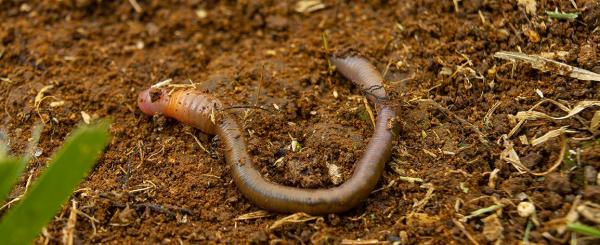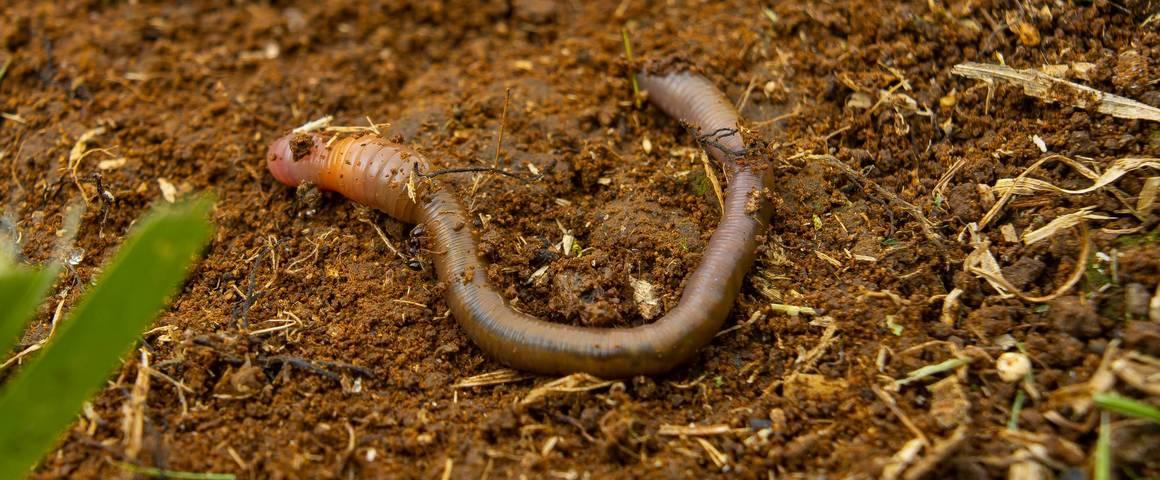
Interactions between chlordecone and earthworms
The aim of this project is to determine whether earthworms can bioaccumulate chlordecone and its degradation products, and to assess how this affects their functional traits, particularly reproduction.

Earthworm of the species Pontoscolex corethrurus © Baptiste Bentameur - CIRAD
In Martinique, it is estimated that around a third of cultivated land is contaminated by chlordecone. The insecticide was primarily used in banana plantings between 1972 and 1993, to control banana weevils. The molecule is toxic to humans and is proving extremely difficult to eliminated from the environment.
Chlordecone transfers from the soil to water, crops and livestock have been largely documented. Wildlife, on the other hand, and more specifically the soil macrofauna, has never previously been studied. A scientific team recently took samples in contaminated areas from individuals belonging to seven invertebrate species, including earthworms, ants, snails and millipedes.
"By soil macrofauna, we mean any living organism visible to the naked eye", says Mathieu Coulis, a CIRAD soil ecology researcher and co-author of the study. "As these organisms are very small, it has always been difficult to measure their degree of contamination. For ants, for instance, we had to find 160 individuals of the same species. A few years ago, we would have needed a thousand: chlordecone analysis techniques have made substantial progress."
Molecules may sometimes accumulate in an organism, reaching higher concentrations than in the surrounding environment. This is known as bioconcentration. In general, this involves repeated direct contact or ingestion. In the case of the soil macrofauna, certain invertebrates have a soft body that may facilitate contamination through contact. The other possible hypothesis rests on food types: detritivores, which feed on plant debris in the soil (dead leaves, dead wood, etc), potentially ingest more chlordecone than herbivores.
The results suggest that ingestion is the main contamination factor. One detritivorous earthworm had a contamination rate between 10 and 20 times that of the surrounding environment. In comparison, a herbivorous snail species was only very slightly contaminated, with concentrations 15 times lower than in its environment. This was despite the fact that both have soft bodies. Millipedes, on the other hand, had contamination levels five times higher than that of the surrounding soil. They are also detritivores, like earthworms, but with an exoskeleton.
| Species | Contamination compared to the environment | Feeding type | Body type | |
|---|---|---|---|---|
| Earthworm | 20x more | Detritivore | Soft-bodied | |
| Millipede | 4.7x more | Detritivore | Exoskeleton | |
| Ant | 3.5x less | Omnivore | Exoskeleton | |
| Snail | 14.9x less | Herbivore |
|
Aside from their concerns about these results, the scientists suggest that earthworms could act as bioindicators of soil contamination by chlordecone in Martinique. "In some zones, chlordecone analyses did not show anything in the soil, whereas the molecule could be quantified in earthworms. Analysing earthworms could therefore serve to detect chlordecone in largely unpolluted soils. This line of research is currently being pursued as part of the CHLOR2NOU project", Mathieu Coulis explains.

The aim of this project is to determine whether earthworms can bioaccumulate chlordecone and its degradation products, and to assess how this affects their functional traits, particularly reproduction.
"Earthworms represent the greatest terrestrial animal biomass on the planet", says Lai Ting Pak, a CIRAD agro-hydrology researcher and co-author of the study. "In rangelands, the earthworm biomass is much greater than that of cows. They dig tunnels that let air into the soil, and they therefore play a significant role in soil hydric and biological functioning." Ting Pak had previously studied chlordecone contamination of water on the island, and it was her interdisciplinary work with ecologist Mathieu Coulis that produced these new results.
In biology, bioconcentration is just one form of bioaccumulation. There is another: bioamplification. "This is the gradual increase in the concentration of a molecule in an organism, as we move up the food chain", Mathieu Coulis explains. "Earthworms are at the bottom of the trophic chain. The question is therefore whether earthworm predators are also contaminated, and to what extent."
An initial chlordecone analysis was carried out on a lizard endemic to Martinique, Dactyloa roquet. Average contamination rates proved to be nine times higher than that of the environment, and higher than in the prey the lizards consume, bearing out the bioamplification hypothesis. These small green lizards, which are commonly found across the island, largely feed on the soil macrofauna. "Dactyloa roquet does not eat earthworms, but does eat contaminated small organisms, and is in turn contaminated", says Mathieu Coulis. "Other animals, such as birds, eat earthworms, and there is concern that chlordecone might be transferred beyond the plots initially affected as a result of their movements."
Since chlordecone was banned in the French West Indies, the focus has been on how human population groups become contaminated. Soils, water, crops and livestock have been studied extensively. This new study has raised the alarm about the ecotoxicological risks for the island's wildlife. "The concentrations observed are very high, for very small organisms", Lai Ting Pak says. "Even if earthworms live for just a few months, it is highly likely that at this high level of contamination, the impacts on its organism will be both rapid and substantial."
The results also call for a greater understanding of the extent to which the various links in the food chain are exposed to chlordecone. For Eric Justes, Director of CIRAD's PERSYST department, "this novel study highlights the need to be vigilant about ecosystem health, in addition to taking the appropriate steps in terms of preventive public human health policy".
This work was carried out under the umbrella of the Territoires Durables project, using field study plots from the BANABIO project.
Mathieu Coulis, Julie Senecal, Yoann Devriendt-Renault, Thierry Guerin, Julien Parinet, Lai Ting Pak. 2024. Fate of chlordecone in soil food webs in a banana agroecosystem in Martinique. Environmental Pollution